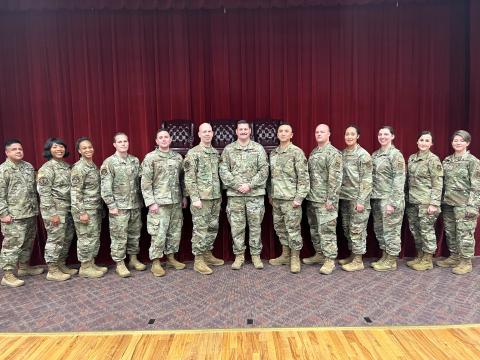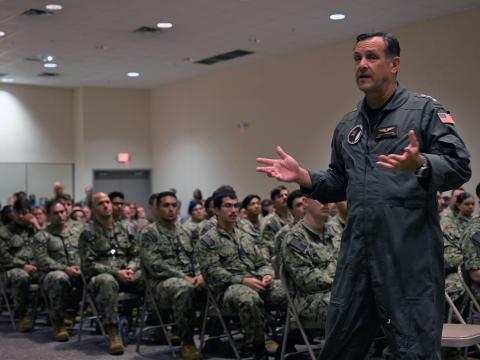Navy Exploits the Power of the Force
Service moves full speed ahead on transformation.
The U.S. Navy is launching a new initiative that expands the concept of network-centric warfare from the purely technical world to the operations doctrine domain. The paradigm will affect every aspect of the Navy—from acquisition processes to transportation, from information sharing to targeting. Military leaders believe this new approach will increase combat effectiveness and better support joint and coalition operations.
Cultivating this methodology will require participation from every sector of the Navy, which is appropriate since the goal is to integrate the service’s components more effectively. Although information technology will play a key role, this initiative is about more than putting another network into place. It is the Navy’s accelerated move toward total transformation and for the first time takes into consideration a crucial element—human resources.
The concept, known as FORCEnet, has been under construction for more than three years, but work on it was propelled recently when Adm. Vernon E. Clark, USN, chief of naval operations (CNO), designated Vice Adm. Dennis McGinn, USN, as FORCEnet director. Adm. McGinn is the deputy CNO, warfare requirements and programs, N-7, and he will lead and coordinate FORCEnet’s development. The commanding officers of all the major naval commands support the initiative, and top Navy officials agree that the heads of industry will be essential in this collaborative endeavor.
John D. Robusto, director, network-centric warfare initiatives, Naval Air Systems Command, Patuxent River, Maryland, describes FORCEnet as the architecture for the building blocks that include warriors, sensors, networks, decision aids, weapons and supporting systems. These will be integrated into a highly adaptive, human-centric, comprehensive system that operates from sea to land and from seabed to space. By exploiting existing and emerging technologies, FORCEnet will enable dispersed decision makers to leverage military capabilities and dominate the entire battlespace with joint, allied and coalition partners. However, Robusto stresses that this is not just a command and control transformation issue or only military network-centric. It is also business network-centric in terms of acquisition and investments.
Robusto asserts that the state of today’s naval doctrine, processes and technology is the result of work done in a piecemeal manner. “It’s been like asking a construction crew to build a house out in the middle of nowhere without giving them an idea about electrical requirements or plumbing specifications. They do the best they can, but there aren’t any standards or zoning laws as guidelines,” he explains. FORCEnet will define the requirements, not only of the technology but also of the entire service, he adds.
Rear Adm. (Sel.) Robert D. Jenkins III, USN, special assistant to the assistant secretary of the Navy for research, development and acquisition, agrees and says FORCEnet is a blueprint for transformation. “FORCEnet is an umbrella to bring disparate systems together and get rid of stovepipes in thinking, not just technology,” he relates. “What’s out there now is free standing. We’re looking at how to bring this together. There are a lot of programs of record that we have to take a hard look at.”
According to Adm. Jenkins, Vice Adm. Arthur K. Cebrowski, USN (Ret.), director of the Office of Force Transformation, has instructed the FORCEnet task force about how the approach plays into transformation and how FORCEnet itself is transformational. “FORCEnet is looking at capabilities across the spectrum—not where they sit but what they can do. What benefit do they give the warfighter? How much better do they make things for the warfighter?” Admiral Jenkins offers.
The Chief of Naval Operations Strategic Studies Group (SSG) XX, located at the U.S. Naval War College in Newport, Rhode Island, conducted the initial investigation into the FORCEnet concept with an eye on implementing it later this century. However, Adm. Jenkins explains that Adm. Clark examined the ideas that were being discussed and issued a directive to accelerate the work.
“When we started looking at the concept, it was aimed at 2010 and later. Now the goal is to have FORCEnet Block I up in the 2004 to 2006 timeframe and FORCEnet Block II in the 2010 timeframe.” The CNO, Adm. Jenkins explains, realized the urgency to get going on this. “He sees the budget and the adversaries changing and wants to be sure the Navy is ready,” the admiral relates.
The SSG XX report provided metrics that show a significant increase in warfighting effectiveness when certain technologies are employed. Metrics can help distinguish the capabilities that should be pursued from those that do not offer distinct advantages. That information can be useful to both military program managers and industry, Robusto offers.
SSG XX identified five areas that compose FORCEnet. First, the Navy’s leadership must be fully committed to developing and implementing the concept. Robusto and Adm. Jenkins concur that the leaders of all the commands and departments have been completely supportive and will continue to be a large part of FORCEnet development.
Experimentation was the second item the SSG XX identified as critical to the new paradigm. This includes the rapid prototyping of new technologies and prompt insertion of these capabilities into the field.
The third element of FORCEnet is human resources, which is an item that Adm. Jenkins admits was not a specific requirement in the past. “We have to be honest. There was no mandate to include the human element, so the human sensory piece was an afterthought,” he shares. FORCEnet is being designed from the beginning with personnel in mind.
Full cooperation in the acquisition arena was the fourth item the SSG XX identified. It is in this area that industry can make a significant contribution, and the FORCEnet task force is interested in hearing from business leaders, Robusto says. “Industry, don’t be shy about coming to us, but we want to see the leadership of companies. They have to understand what this is all about so that they can direct their efforts and offerings to it. Understand network-centric warfare. Understand the transformation. Industry has to own some part of this. We have to work together and work together quickly, and the solutions need to come to us pre-integratable,” he maintains. The Navy’s leadership plans to hold engineers to their viewgraphs. There will be accountability, he adds.
Adm. Jenkins agrees that FORCEnet will change the way the Navy and industry interact. “We will engage industry differently. We want to use the intellectual capital of industry up front,” the admiral reveals. “This is a new paradigm. There needs to be an open dialogue. Industry provides the innovation engine.” In recent years, the admiral points out, industry leaped ahead in research, development and acquisition and then brought its products to the military to buy. This no longer will be the case, he contends. “They have to know what we need. They can’t afford to put money into something we don’t need or that won’t work with the paradigm.”
Robusto agrees. “We don’t own the innovation trail anymore—industry does—but we own the need trail. There are things that the military requires that no one else does.”
The final piece of the FORCEnet picture is fleet operations. Adm. Jenkins relates that the paradigm must address the needs and role of this segment. “The systems must aggregate power and project it. From the secretary of defense to the systems commands, all will stay engaged in this,” he says. Robusto adds that the crux of this effort is innovation, integration and implementation, and the systems commands will both lead and participate in its design.
One additional “I” word that is critical in the transformation discussion is interoperability, and it is an issue that has been at the top of the military priority list for many years. “Interoperability is not a technology problem; it’s a leadership issue,” Robusto contends. “It is the responsibility of everyone, both in the military and industry, to ensure interoperability. There are cost constraints, but sometimes the problem with achieving interoperability is that there are stovepiped requirements. To solve this, we have to balance tactics, technology and procedures.”
Although FORCEnet is not strictly about technology, Robusto identifies several capabilities that will be especially useful to the transformation effort and beyond. “There is no computer-aided design system for C4I [command, control, communications, computers and intelligence]. Modeling and simulation technology has to get on steroids,” he states, adding that the technology that is now used to train pilots to fly needs to be brought up to the level where it can be used for flight testing.
Among the information technologies FORCEnet will examine and use are collaborative capabilities, wargaming, advanced data mining, and radar and sensors that go beyond Link 16. Technological improvements also will be sought in weapons, transportation and power supplies. In addition, techniques for collecting metrics are required, including those that provide insight into the human-in-the-loop aspect of systems.
Despite this push to see improvements in technology, Robusto emphasizes that FORCEnet is about more than software and hardware. “In some cases, technology leads doctrine. In this case, it is doctrine that is leading,” he relates.



